The products ImageMaster® HR and Universal fulfill highest customer requirements for image quality testing. ImageMaster® HR is the preferred MTF test station for R&D labs worldwide.
Measurements with increased accuracy and flexibility are the main focus.
The wide model range of ImageMaster® HR and Universal allows measurement of a large number of optical parameters over a wide spectral range. The ImageMaster® HR can be used to measure lenses in the spectral range NUV-VIS-NIR-MWIR-LWIR. The ImageMaster® Universal is flexibly suitable for MTF Testing in the entire spectral range UV-VIS-NIR-SWIR-MWIR-LWIR.
The ImageMaster® HR and Universal are available in numerous variants and also enable with different collimator options, e.g. mirror collimators, precise measurement of samples with large focal length ranges. For optical systems that are used under different temperature and weather conditions, measurements in a wide temperature range are possible with the ImageMaster® HR TempControl.
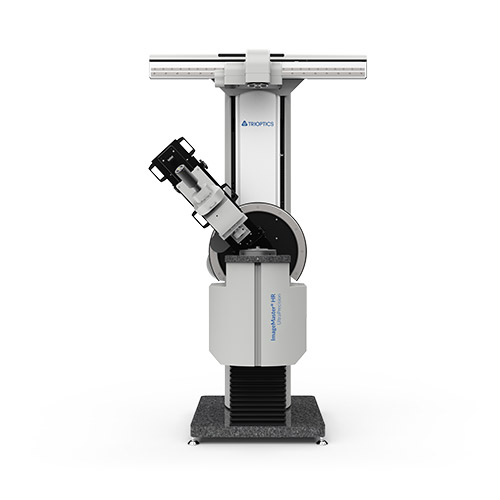
High-precision air bearing sample holder
Increased mechanical stability
Enhanced measurement reproducibility
Accuracy traceable to international standards
Fully or semi-automated, ultra-accurate, multifunctional MTF test station
R&D MTF test station for medium sized samples
MTF measurement at finite and infinite conjugates
Instrument available for NUV / VIS / NIR
Vertical set up for most convenient and easy lens positioning
Optimal design prevents vignetting
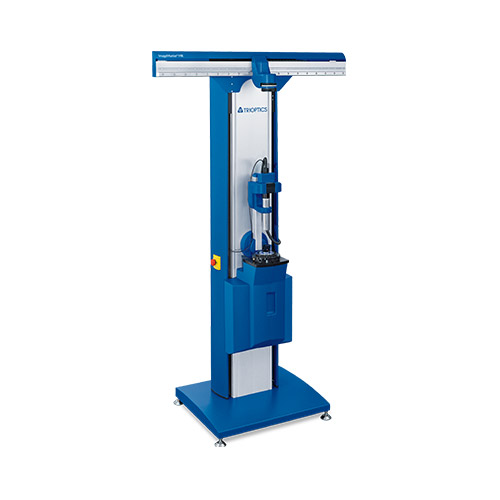
Fully or semi-automated, ultra-accurate, multi-functional MTF test station
Accuracy traceable to international standards
MTF measurement at finite and infinite conjugates
For small and medium sized samples
Available for NUV/VIS/NIR/LWIR spectrum
Vertical set up for most convenient and accurate lens positioning
Ultra-wide field angle of ± 110°
Optimal design prevents vignetting
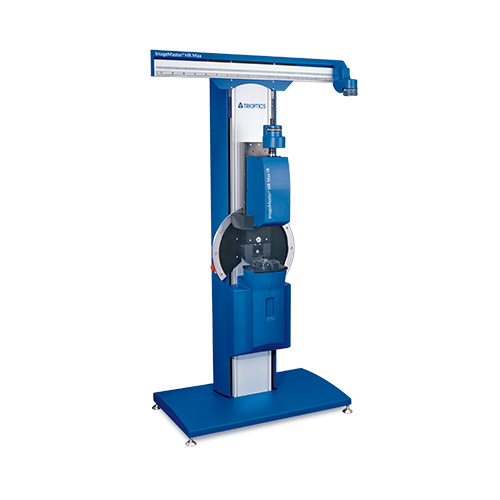
Available for NUV/VIS/NIR spectrum
Includes a high-quality mirror collimator, halogen light source and high resolution camera sensor
Accuracy traceable to international standards
Fully or semi-automated, ultra-accurate, multi-functional MTF test station
For medium sized samples
MTF measurement at finite and infinite conjugates
Vertical set up for most convenient and easy lens positioning
Ultra-wide field angle of ± 70°
Optimal design prevents vignetting

Available for NUV/VIS/NIR/MWIR/LWIR spectrum (SWIR on request)
Includes a high-quality mirror collimator, broadband IR light source and IR focal plane array image sensor
Accuracy traceable to international standards
For small and medium sized samples
MTF measurement at finite and infinite conjugates
Time-saving area sensor method for LWIR and MWIR
Vertical set up for most convenient and easy lens positioning
Ultra-wide field angle of ± 70°
Optimal design prevents vignetting
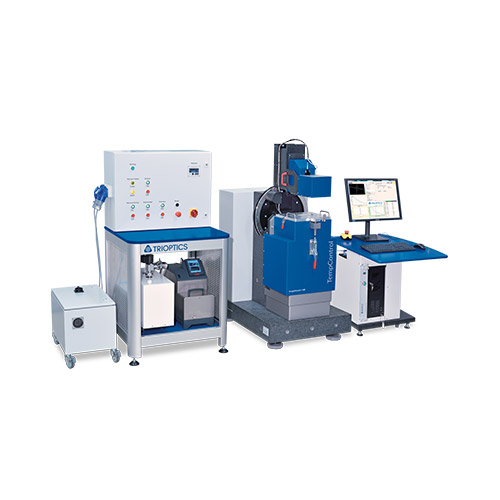
Functionality testing of athermal optical designs
Temperature range: Standard: -10°C to 120°C, Upgrade: -40°C to 120°C
Determination of the optical performance for a set of parameters
Specially developed temperature stable design
Test samples are isolated from the environment via a vacuum
Measurements in both the VIS spectrum and NIR range and easy conversion
Measurements in MWIR- and LWIR range
Stable mechanical design made of granite

Accurate measurement of virtually any existing lens system: infinite, finite, afocal
For high performance photographic imaging lenses up to high resolution telescopes
Spectral range of the MTF measurement from UV to visible spectrum to IR (NIR/SWIR/MWIR/LWIR)
On-axis and off-axis-measurement of the MTF
Modular and upgradable design
Module exchange within a few minutes (e.g. changing from VIS to IR)
MTF values traceable to international standards
Cover for collimators protects from ambient light and air turbulences
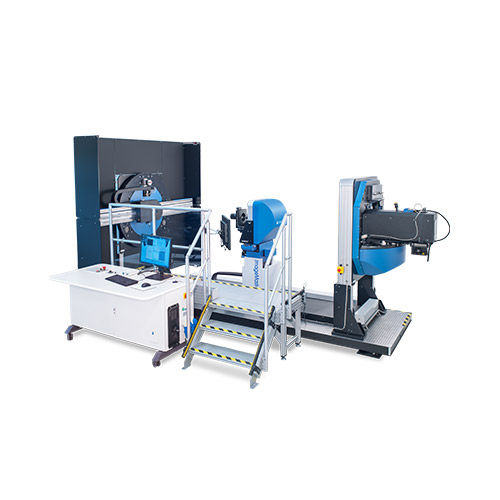
Full field measurement for infinite and finite measurement situations
Measurement of the modulation transfer function (MTF) off-axis and on axis
MTF values based on international standards
Fully automated, ultra-accurate, multi-functional MTF- Test Station
Optimal design prevents reduction of the image brightness
Motorized finite conjugates stage for long conjugate distances
High quality image analyzer
Collimator rotates around two axes to cover an object angle of ±60° over the full field azimuth
The reticle including illumination unit cover a rectangular object field of ±1100mm (horizontal) and ±800mm (vertical)

MTF on-axis and off-axis
Effective Focal Length (EFL)
Distortion
Fully automated, ultra-accurate, multi-functional MTF- Test Station
Optimal design prevents reduction of the image brightness
Motorized finite conjugates stage for long conjugate distances
High quality image analyzer
Collimator rotates around two axes to cover an object angle of ±60° over the full field azimuth
The reticle including illumination unit cover a rectangular object field of ±1100mm (horizontal) and ±800mm (vertical)
Effective Focal Length (EFL)
Flange Focal Length (FFL)
MTF vs Frequency
MTF vs Field
MTF vs Focus
MTF vs Focus vs Field
Field curvature
Distortion
Depth of focus
Chief Ray Angle
MTF on-axis and off-axis
Effective Focal Length (EFL)
Distortion
Field curvature
Lateral and longitudinal chromatic aberrations
Astigmatism
Chief Ray Angle
PSF (Point Spread Function)
Depth of focus
Field of view
Back focal length (absolute/relative)
Relative and absolute transmission
Relative illumination

| Parameter | ImageMaster® HR VIS |
ImageMaster® HR IR |
ImageMaster® HR MAX |
ImageMaster®® HR MAX IR | ImageMaster® HR UltraPrecision |
| Optical set up | Infinite conjugates (finite optional) |
Infinite conjugates |
Infinite conjugates (finite optional) |
Infinite conjugates | - |
| Max. off-axis angle | Up to ±110° | Up to ±110° | Up to ±70° | Up to ±70° | - |
| Spectral range | 450 nm … 750 nm, halogen (NIR/NUV optional) | LWIR: 8 µm … 12 µm | VIS /NIR NUV optional |
NIR, NUV, LWIR: 8 µm … 12 µm VIS: 0.4 µm … 0.9 µm MWIR : 3 µm … 5 µm SWIR: 0.9 µm … 1.7 µm on request |
- |
| Azimuth range | 360° | 360° | 360° | 360° | 360° |
| Max. image height | ±23 mm | ±23 mm | ±23 mm | ±23 mm | ±23 mm |
| Clear aperture | - | - | up to 100 mm | up to 100 mm | up to 100 mm |
| Collimator range | 50 mm … 500 mm | 50 mm2) | 50 mm … 1,000 mm | 50 mm … 1,000mm2) | 50 mm … 1,000 mm |
| EFL range of the sample | 1 mm … 150 mm 1) | 1 mm ... 10 mm 1),2) | 1 mm … 200 mm 1) | 1 mm … 200 mm 1) | 1 mm … 200 mm 1) |
|
Spatial frequency (in specification) Max. spatial frequency |
0 lp/mm … 500 lp/mm 1,000 lp/mm (depending on sample) |
0 lp/mm … 60 lp/mm |
0 lp/mm … 500 lp/mm 1,000 lp/mm (depending on sample) |
VIS/NIR/LWIR: 0 lp/mm … 60 lp/mm MWIR: 0 lp/mm … 100 lp/mm |
0 lp/mm … 500 lp/mm 1,000 lp/mm (depending on sample) |
|
Accuracy (MTF on-axis and off-axis) |
±0.02 MTF | ±0.03 MTF | ±0.02 MTF | ±0.03 MTF | ±0.02 MTF |
|
Repeatability (MTF on-axis and off-axis) |
±0.005 MTF | ±0.02 MTF | ±0.005 MTF | ±0.02 MTF | ±0.005 MTF |
1) Depend on mirror colimator
2) Larger on request
Motorized ultraprecise sample holder with a radial runout better than 3 μm / 6 arcsec for more accurate measurements of tilt sensitive samples
Additional filters and reticles for all measurement applications: Filters for NUV, VIS, NIR / reticles extendable, e.g. for PSF and veiling glare measurements
Extensions of nearly all stages to suit the customer’s needs
Motorized finite conjugate stage with manual or motorized object generator. The motorized object generator illuminates the reticle in the direction of the sample
for off-axis measurements. This is needed for small samples or low light conditions
Various collimators with focal length and clear aperture for high flexibility
Motorized reticle and filter changer for infinite conjugate to measure with least interaction of an operator. The lateral chromatic aberration can be measured more accurately as the filter will be changed automatically with no vibration of a manual change
With the veiling glare upgrade for ImageMaster® HR it is possible to measure the Glare Spread Function (GSF). By off-axis measurements and rotation of the specimen around its center, the GSF can be measured over the entire field of view of the sample.

MTF on-axis and off-axis
Effective Focal Length (EFL)
Distortion
Field curvature
Lateral and longitudinal chromatic aberrations
Astigmatism
Chief Ray Angle
PSF (Point Spread Function)
Veiling Glare
Depth of focus
Field of view
Flange Focal Length (FFL) relative
Relative illumination
Line Spread Function (LSF)
MTF
Distortion
Effective Focal Length (EFL)
Shift, tilt and defocus of the sensor
Image field curvature of the lens
Lateral and longitudinal chromatic aberrations
Upgrade for measurements in the near infrared range
Upgrade for LWIR- and MWIR-measurement
Upgrade for distortion measurement
Upgrade for ultra-precise FFL measurements
Upgrade for measurements in the extended temperature range from -40°C to +120°C
UV
VIS / NIR / SWIR
MWIR/LWIR
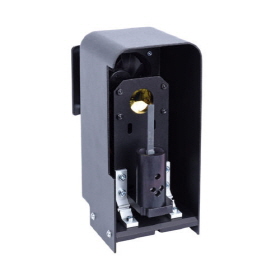
UV (scanning based)
VIS (camera/scanning based)
NIR (camera/scanning based)
SWIR (scanning based)
MWIR (kamera-/scannerbasiert)
LWIR (kamera-/scannerbasiert)
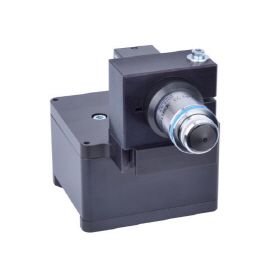



Finite Stage 2m
Finite Stage 3m
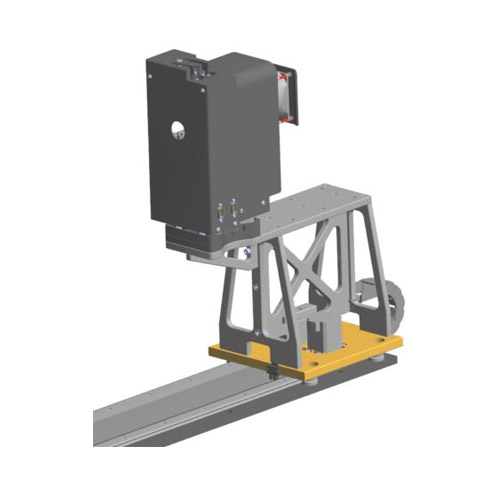
Reticle and filter changer
Reticles
Filter

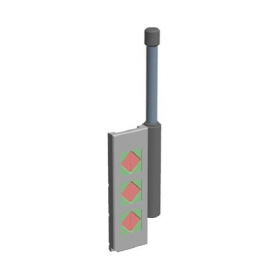
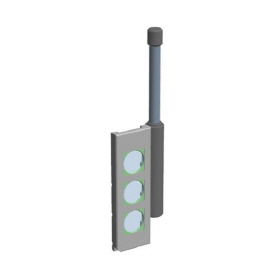
Decollimator lens for VIS
Decollimator lens for MWIR
Decollimator lens for LWIR
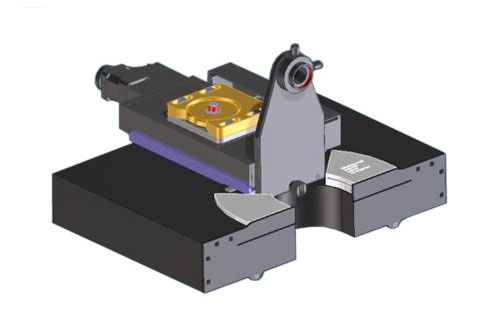
The Modulation Transfer Function (MTF) is an important aid to objective evaluation of the image-forming capability of optical systems. Not only that the MTF provides a means of expressing the imaging quality of optical systems objectively and quantitatively, but it can be calculated from the lens design data. In this way it allows optical and systems designers to predict reliably the performance of the optical systems. The manufacturers can compare the image quality of the manufactured lenses with the design expectations.
The MTF measurement is an important tool for the objective assessment of the imaging performance of optical systems. Moreover, the MTF can be calculated from the lens design data giving designers of optical systems the ability to predict system performance reliably. The manufacturer can then compare the image quality of real lenses with the expectations from the design phase.
The Modulation Transfer Function (MTF), describing the resolution and performance of an optical system, is the ratio of relative image contrast divided by relative object contrast MTF = Relative Image Contrast/Relative Object Contrast. When an object (illuminated target or reticle) is observed with an optical system, the resulting image will be somewhat degraded due to inevitable aberrations and diffraction phenomena. In addition, a real lens will not fully conform to the design data.
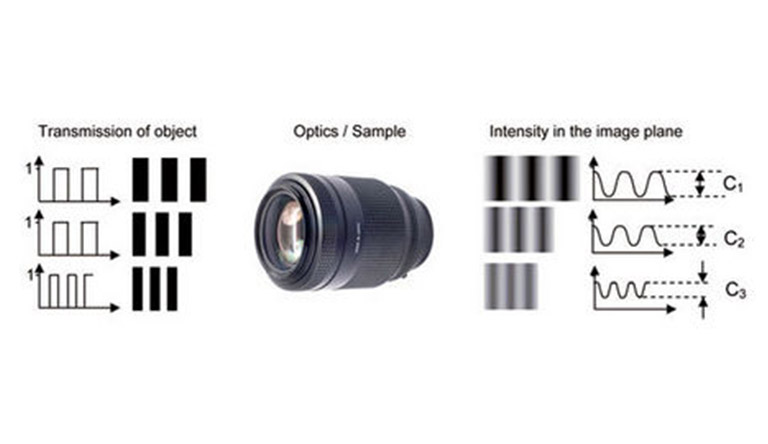
Perfect grid pattern is imaged through the sample into the image plane
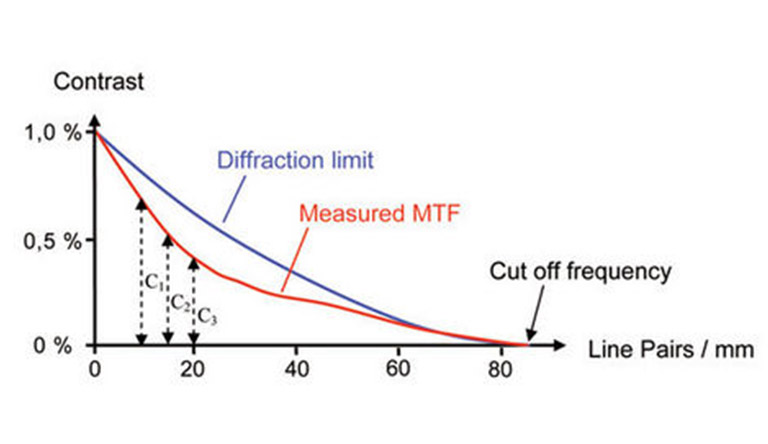
Contrast vs spatial frequency. This figure shows the MTF of the diffraction limited optics and a measured MTF referring to Fig. 1
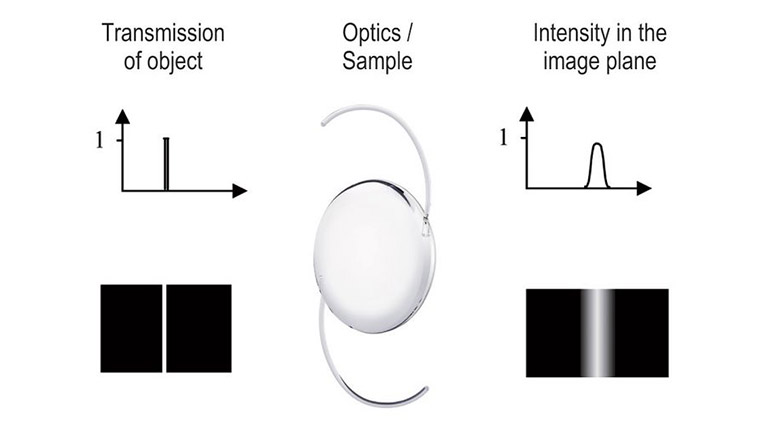
The image of a perfect slit is called “Line Spread Function”
Manufacturing errors, assembly and alignment errors in the optics will deteriorate the overall imaging performance of the system. As a result, in the image, bright highlights will not appear as bright as they do in the object, and dark or shadowed areas will not be as black as those observed in the original patterns. In general an illuminated target can be defined by its spatial frequency (number of bright and dark areas per millimeter) and the contrast (the apparent difference in brightness between bright and dark areas of the image).
By convention, the modulation transfer function is normalized to unity at zero spatial frequency. For low spatial frequencies, the modulation transfer function is close to 1 (or 100%) and generally falls as the spatial frequency increases until it reaches zero. The contrast values are lower for higher spatial frequencies as shown above. As spatial frequency increases, the MTF curve falls until it reaches zero. This is limit of resolution for a given optical system or the so called cut off frequency (see figure below). When the contrast value reaches zero, the image becomes a uniform shade of grey.
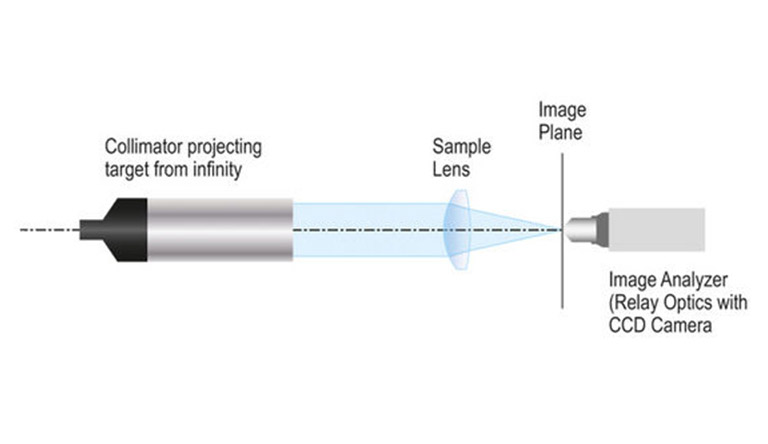
Typical setup for off-axis MTF measurements.
The grids shown are actually no longer used in order to measure the MTF. Modern MTF-Testers like the ImageMaster® use a single illuminated slit on opaque background as the object. From a mathematical point of view a single slit can be regarded as the sum over all spatial frequencies (Fourier synthesis). All frequencies contribute with the same amplitude (=1) to this slit not taking the finite slit width into account for this description. This single slit will be imaged into the image plane of the sample. Due to diffraction and aberrations there will be no perfect slit image in this plane, instead the slit image is broadened. It represents the so called Line Spread Function (LSF). On the basis of Fourier analysis the contribution of each spatial frequency to the LSF can be calculated. Actually the amplitude of each spatial frequency is equal to the contrast at this frequency. The Fourier analysis of the Lines Spread Function corresponds to the MTF of the sample. Taking a single image of the LSF unveils the complete MTF. Alternatively it is also possible to use a cross (i.e. two perpendicular slits) for the target. This enables the ImageMaster® to measure the MTF in two image directions simultaneously provided a CCD camera is used for the image analyzer. And finally a pinhole target can be used as the object, too. The image of a pinhole target is called Point Spread Function. This function contains the complete MTF information in all image directions. The basic terms and mathematical relations used for MTF are described in the ISO 9334 standard.
The modulation transfer function varies not only related to the spatial frequency but also with the position in the field of view. The MTF measurement along the axis of symmetry of the optical system is known as on-axis measurement.
To completely characterize the imaging performance of an optical system, the MTF must be measured at different positions within the field of view. The MTF measurement within the field of view is known as off-axis measurement. In order to achieve an off-axis measurement, the target is moved in the field of view at the desired object position and the image analyzer to the corresponding image position.
The MTF measurement can be accomplished at a single wavelength or in a spectral range covering a finite band of wavelengths. The resulting measurement data are known as monochromatic or polychromatic MTF values, respectively.
Usually the MTF is used in its one-dimensional form, calculated for one azimuthal section through the image plane. The azimuth (section plane) of the object pattern is called sagittal azimuth when the prolongation of the slit or object passes through the reference axis. When the prolongation of the slit pattern is perpendicular to the reference axis, the azimuth is called tangential azimuth.
In this so-called finite-finite imaging condition the illuminated slit or crosshair target is directly moved in the object plane of the sample. In the more common infinite-finite imaging condition, the illuminated slit or crosshair is part of a collimator projecting the target to infinity. The collimator is then oriented at different off axis angles for characterizing the MTF at the corresponding image fields. Figure 4 shows the typical setup for this imaging condition.
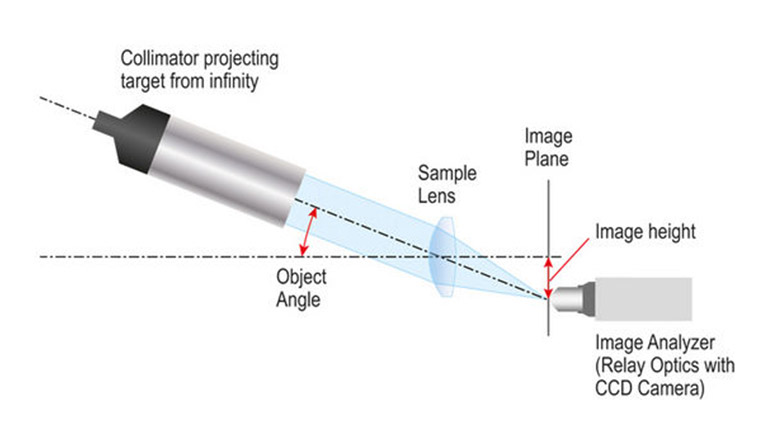
Typical setup for off-axis MTF measurements.
The Effective Focal Length (EFL) or equivalent focal length is the distance from the focal points of the lens to the respective principal planes. The EFL determines the magnification of a lens and hence the image size. Because the principal planes are usually inside the lens at unknown locations, the direct measurement of the EFL is difficult.
However, the EFL can be measured quickly and with sufficient accuracy using the method of measuring the magnification of a double bar target. Certified master lenses from PTB (National German Standard Institute) are available at TRIOPTICS and are used for the calibration of the measurement setup. The measurement data are thus directly traceable to international standards.
Distortion is the percentage of change in magnification between the center of the field of view and off-axis positions in the field of view. In order to determine the distortion a different method of measuring the EFL is used:
This procedure requires a comparatively large number of measurement points with accurately known object angles and field positions. For this reason ImageMaster® instruments with dedicated distortion measurement option feature a high precision angular encoder for the object generator (accuracy 5 arcsec) and a high precision linear encoder for the image field stage (accuracy 0.2 µm). This way, the EFL is calculated as an absolute quantity, not depending on calibration parameters.
The depth of focus is the extent of the region in front of and behind the image plane in which the image will appear to be sharp.
The depth of focus can be determined using a “through focus scan” of the MTF and setting appropriate tolerances for the drop in MTF. The depth of focus between the set tolerances will be measured and displayed.
A more complex measurement can be done simulating the range of object distances covered by the lens and measuring the MTF at the corresponding image distances.
Field curvature is an optical aberration in which the focus position changes from the center to the edge of the field of view. The curvature of the image field is a lens aberration that causes a flat object surface to be imaged onto a curved surface rather than a plane.
In the presence of the astigmatism, there are two separate astigmatic focal surfaces in orthogonal directions.
To determine the field curvature a set of through focus measurements at different positions in the field are taken. The MTF maxima and the corresponding positions in field are determined. The values are collected by a software routine and displayed in graphical and tabular form.
Relative illumination in an optical system is the gradual reduction of the image brightness with increased off-axis angle. This phenomenon results from the fall of, which is approximated by the cos4 or “cosine four law of the illumination falloff. Additionally there is the effect of the apparent limitation of the clear aperture depending on the field angle. Relative illumination is defined as the ratio of the central transmission and the transmission at the edge of the field of view.
The ImageMaster®-Software measures continuously the light intensity of the test pattern in order to avoid saturation. In this way the necessary data is available for determining the relative illumination following ISO 13653:1996.
A chief ray is the ray from an off-axis object point which passes through the center of the aperture stop of an optical system. The chief ray enters the optical system along a line directed towards the midpoint of the entrance pupil, and leaves the system along a line passing through the center of the exit pupil. To measure the angle between the optical axis and the chief ray on the image side the following method is used: The lens under test is illuminated by the collimator at different angles corresponding to the object sided chief ray angles. The detector head is moved to the image field position at which the lens focuses the image. Now the detector head is moved towards the lens in small steps while the software registers the lateral movement of the focused spot. From these lateral movements the CRA is calculated.

Measurement procedure of chief ray angle
The F-Number of a lens is defined by the ratio between the EFL and the diameter of the entrance pupil. The ImageMaster® series instruments use the ISO-517 method to accomplish the measurement: First the EFL is measured according to the procedure described before. Then the sample is turned around with the entrance pupil facing towards the detector head. The diameter of the entrance pupil is measured by first focusing on the left, then on the right edge of the pupil. The travelling distance of the image field stage represents the diameter of the entrance pupil. By choosing the proper head lens of the detector head even pupils positioned far inside of the system under test can be measured.
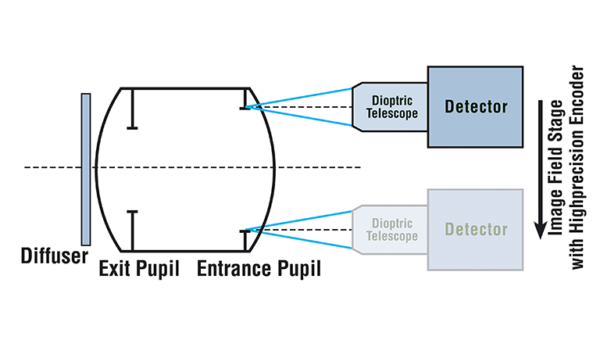
Measurement procedure of F-number
Due to the dispersion of refractive optical systems the image position and also magnification of an optical system depends on the wavelength of the light. The dependence of the axial image position on the wavelength is called Chromatic Focal Shift. The dependence of the magnification on the wavelength is called Lateral Chromatic Aberration. Both aberrations can be measured with the ImageMaster®. The collimator of the ImageMaster® is equipped with different narrow bandwidth color filters. Together with the highly corrected relay optics this enables the system to focus in axial direction to the different image positions for different colors. The image position measurement can be done with submicron accuracy. Measuring the lateral image position for different object angles enables the system to measure the lateral chromatic aberration.

Principle of the measurement of the axial chromatic aberrations